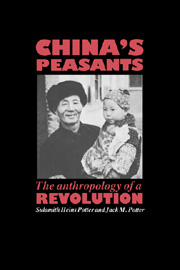Book contents
- Frontmatter
- Contents
- List of illustrations
- List of tables
- Preface
- Notes on the text
- Map 1 China
- 1 The old “feudal” order: Zengbu before Liberation
- 2 Establishing the new order
- 3 The ordeal of collectivization
- 4 The Cultural Revolution
- 5 Maoist society: the production team
- 6 Maoist society: the brigade
- 7 Maoist society: the commune
- 8 Impatient aspirations: transition to the post-Mao period
- 9 The cultural construction of emotion in rural Chinese social life
- 10 Marriage, household, and family form
- 11 Chinese birth planning: a cultural account
- 12 Lineage and collective: structure and praxis
- 13 Party organization
- 14 The party ethic: a devotion born of distress and enthusiasm
- 15 A caste-like system of social stratification: the position of peasants in modern China's social order
- 16 The Chinese peasants and the world capitalist system
- 17 The crystallization of post-Mao society: Zengbu in 1985
- References
- Index
17 - The crystallization of post-Mao society: Zengbu in 1985
Published online by Cambridge University Press: 02 December 2009
- Frontmatter
- Contents
- List of illustrations
- List of tables
- Preface
- Notes on the text
- Map 1 China
- 1 The old “feudal” order: Zengbu before Liberation
- 2 Establishing the new order
- 3 The ordeal of collectivization
- 4 The Cultural Revolution
- 5 Maoist society: the production team
- 6 Maoist society: the brigade
- 7 Maoist society: the commune
- 8 Impatient aspirations: transition to the post-Mao period
- 9 The cultural construction of emotion in rural Chinese social life
- 10 Marriage, household, and family form
- 11 Chinese birth planning: a cultural account
- 12 Lineage and collective: structure and praxis
- 13 Party organization
- 14 The party ethic: a devotion born of distress and enthusiasm
- 15 A caste-like system of social stratification: the position of peasants in modern China's social order
- 16 The Chinese peasants and the world capitalist system
- 17 The crystallization of post-Mao society: Zengbu in 1985
- References
- Index
Summary
By 1985, six years of accumulated changes under the post-Mao policies had transformed Zengbu. There was a new and complex economic base containing multiple and mixed modes of production. There were capitalist joint venture processing factories. There were socialist economic enterprises at every level. There were new household-based modes of production, both in agriculture and in petty commerce. The countryside has experienced a dramatic increase in economic prosperity. Considered separately, each of the modes of production has had social consequences which require analysis, and considered in relationship to one another, the modes of production have produced new coherences and new conflicts which are the basis for a new kind of social order.
The increase in prosperity and the economic growth of the Chashan countryside between 1979 and 1985 have been remarkable. The peasants' new prosperity is demonstrated by statistics on the ownership of consumer goods compiled by the cadres as their measure of progress. In 1979, only 305 of Chashan district's households had television sets; by 1985, 1,832 households, or one-fourth of those in the district, owned a set. In 1979, there were only 8 refrigerators in the commune, all collectively-owned; by 1985, there were 485. In 1979, there were no electric washing-machines in the commune; by 1985, 5 percent of the households owned washers. The number of cars, trucks, and motorcycles had grown from 32, in 1979, to 156, in 1985.
- Type
- Chapter
- Information
- China's PeasantsThe Anthropology of a Revolution, pp. 327 - 339Publisher: Cambridge University PressPrint publication year: 1990



